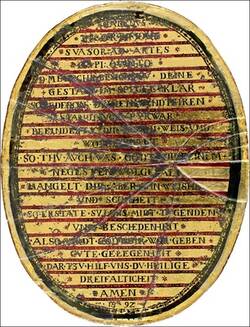This huge decorative mirror is a splendid example of the goldsmith’s art – in the style of German Mannerism. However, it was never intended to be used. Its pictorial design follows a complicated programme, an allegory of the Holy Roman Empire – that group of states in western and central Europe ruled first by Frankish and then by German Kaiser for ten centuries. The Holy Roman Empire was, as Voltaire said, ”neither holy, nor Roman”, but it had an idealised self-image. The monumental frame, which has the character of an epitaph, is overflowing with ornamentation. Trophies, animal-heads, fantastic hybrid creatures, masks and figures are packed into it. There are so many that we can’t possible talk about them all individually. The symbolism is derived from Nebuchadnezzar’s dream, as narrated in the Bible, in the Book of Daniel. It prophesied the downfall of four great empires: Assyria, Persia, Greece and Rome. And prophesied the coming of the Kingdom of Peace and Truth.
In the interpretation you see here, God’s Kingdom is equated with the Holy Roman Empire. That’s the message of the coat-of-arms above the mirror. It shows the imperial double-headed eagle with the coats-of-arms of the member-states. The rulers portrayed on the frame – some of them standing, others on horseback – represent the four empires of the past.
Underneath the mirror is an allegory of good governance. The parable of bad politics is the Judgement of Paris. His choice of Venus as the most beautiful goddess precipitated the Trojan War.
The mirror itself is artistically concealed behind a cover. When the Elector looked into this glass, he became part of the symbolism. In fact, he was at the centre.
Nebuchadnezzar’s Dream was a popular subject towards the close of the sixteenth century. It was interpreted as an omen of war. And in 1618, war did indeed break out. It lasted thirty years. So this remarkable mirror connects a biblical prophecy with the political realities in Europe shortly before 1600.
Elector Christian the First, whose father August had established the Kunstkammer, commissioned this mirror from the Lüneburg goldsmiths Luleff Meier and Dirich Utermarke. Christian himself died in 1591 – before the mirror was finished. The Kunstkammer inventory tells us: his widow had the mirror placed in ”her beloved sons’ Kunstkammer”. In so doing, she was confronting Christian the Second, who had not yet come of age, with his political legacy: the peace of the empire could only be guaranteed by close political relations between the Elector of Saxony and the Emperor, and by strict adherence to the imperial constitution.
Further Media
- Location & Dating
- Lüneburg, dated 1587 and 1592
- Material & Technique
- Silver, embossed, cast, punched, gilded; wood, mirror glass, reverse glass painting, rock crystal, amethysts, garnets, cut glass stones, amelation: mirror glas, gold etching, coloured lacquers, silver foil
- Dimenions
- H 115,0 cm, B 85,0 cm, T ca.13,0 cm; Amelierung: H 14,5 cm, B 11cm; Gewicht ca. 14.620 g
- Museum
- Grünes Gewölbe
- Inventory number
- IV 110
